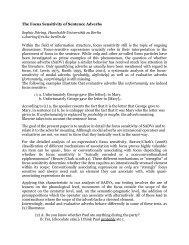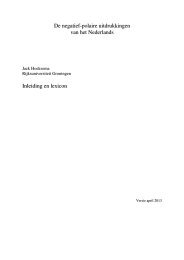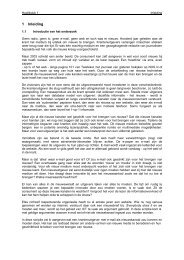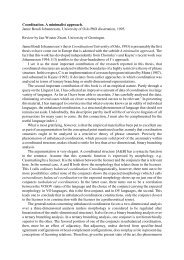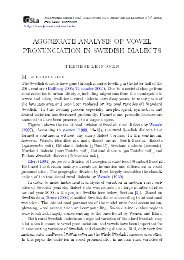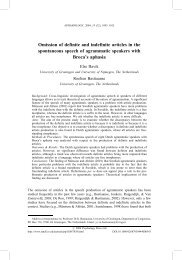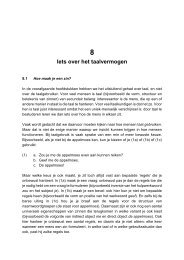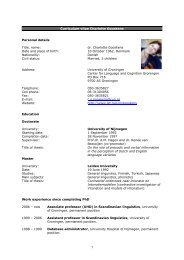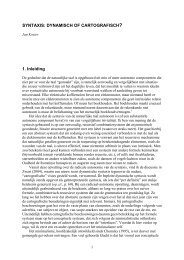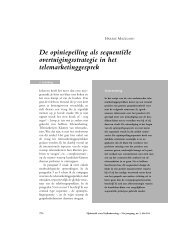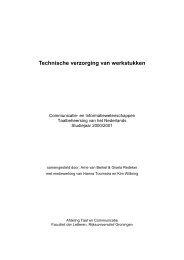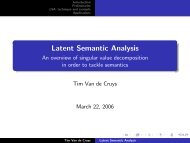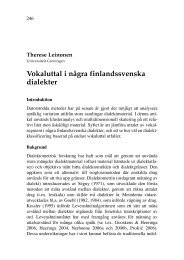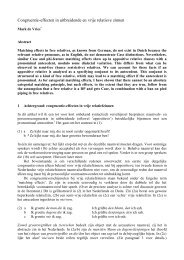Final Report Determinants of Dialect Variation
Final Report Determinants of Dialect Variation
Final Report Determinants of Dialect Variation
Create successful ePaper yourself
Turn your PDF publications into a flip-book with our unique Google optimized e-Paper software.
1) <strong>Determinants</strong> <strong>of</strong> linguistic distances<br />
The first study is based on a high density network <strong>of</strong> 52 settlements which all lie within the<br />
Lower Saxon dialect area <strong>of</strong> the northern Netherlands. Pronunciation distances among the<br />
dialects <strong>of</strong> these settlements are calculated with Levenshtein distance on the basis <strong>of</strong><br />
transcriptions, taken from the Reeks Nederlandse <strong>Dialect</strong>atlassen, 125 words pronunciations<br />
per dialect. Geographic distances between settlements are obtained on the basis <strong>of</strong> longitudelatitude<br />
coordinates and ‘as the crow flies’. Geography accounts for 59% <strong>of</strong> the variance in<br />
the aggregated pronunciation distances when using a linear regression model. The populations<br />
<strong>of</strong> the different settlements were taken from the Geschiedkundige atlas van Nederland; Het<br />
koninkrijk der Nederlanden 1815-1931 Ramaer (1931) and date from around 1815.<br />
Geography and populations sizes are put in one model according to Trudgill’s linguistic<br />
version <strong>of</strong> the gravity model (where the constant is omitted): the population size product <strong>of</strong><br />
two locations divided by the geographic distance between the two locations. The gravity<br />
model did not add explanatory power in comparison to geography only. The contribution <strong>of</strong><br />
the population product independently is moreover positive, contradicting the predictions <strong>of</strong><br />
the gravity model! (Nerbonne & Heeringa, 2007).<br />
A second study is based on 27 varieties in the Netherlands and Flanders. The data had been<br />
collected by Renée van Bezooijen in 2001, pronunciations <strong>of</strong> 100 nouns per variety. The<br />
findings were similar: geography correlated significantly with the pronunciation distances<br />
again and explains 33% <strong>of</strong> the variance, but population size information, although statistically<br />
significant, had only a minor effect. (Heeringa, Nerbonne, Van Bezooijen and & Spruit,<br />
2007).<br />
2) Relationships among linguistic levels<br />
In the period between 1999 and 2002 Jørn Almberg and Kristian Skarbø compiled a database<br />
which consists <strong>of</strong> recordings and phonetic transcriptions <strong>of</strong> translations <strong>of</strong> the fable ‘The<br />
North Wind and the Sun’ in about 50 Norwegian dialects. On the basis <strong>of</strong> 15 <strong>of</strong> these<br />
recordings, pronunciation distances, lexical distances and prosodic distances are measured<br />
among 15 recordings. The pronunciation level significantly correlates with the lexical level<br />
(r=0.49) and prosodic level (r=0.43), and the lexical level significantly correlates with the<br />
prosodic level (r=0.18). The three levels are correlated with perceptual distances, i.e.<br />
distances among dialects as perceived by the speakers themselves. The perceptual distances<br />
were obtained by an experiment carried out by Charlotte Gooskens in the spring <strong>of</strong> 2000. The<br />
three linguistic levels correlate significantly with the perceptual distances, but highest<br />
correlation was found for the pronunciation level. Within the pronunciation level a distinction<br />
was made between consonants and vowels on the one hand, and between substitutions and<br />
insertions/deletions on the other hand. When correlating the separate levels with perception<br />
and using multiple linear regression analyses it appears that especially consonant substitutions<br />
play a major role (Gooskens & Heeringa 2006).<br />
In a second study the levels <strong>of</strong> lexicon and pronunciation are considered, using as data 360<br />
Dutch sites from the Reeks Nederlandse <strong>Dialect</strong>atlassen, 125 words per dialect. Lexical<br />
distances were measured using Goebl's ‘gewichteter Identitätswert’ (GIW), a method in which<br />
the coincidence <strong>of</strong> rarely used words counts more heavily than those <strong>of</strong> more frequent ones.<br />
Pronunciation differences are measured using Levenshtein distance. The two levels correlate<br />
significantly (r=0.63, p



